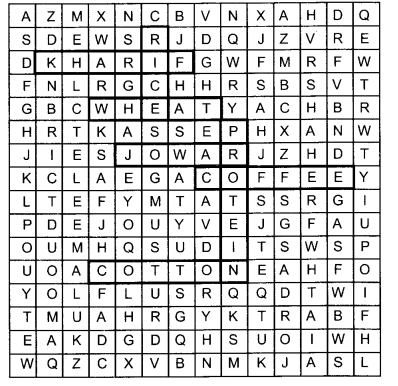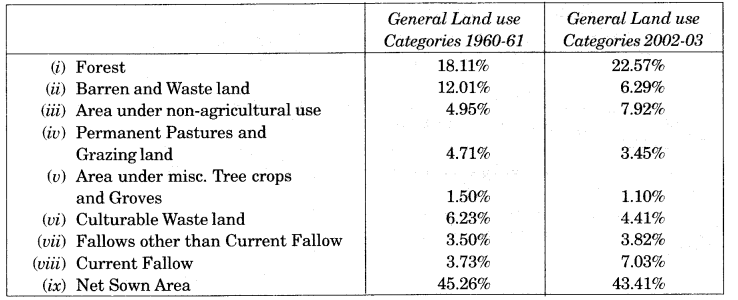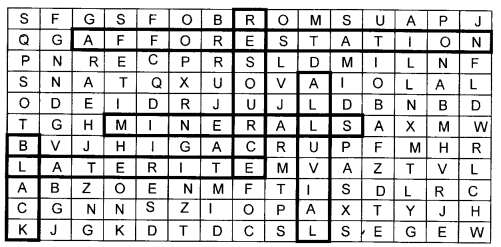NCERT Solutions for Class 10 Social Science Geography Chapter 5 Minerals and Energy Resources
These Solutions are part of NCERT Solutions for Class 10 Social Science. Here we have given NCERT Solutions for Class 10 Social Science Geography Chapter 5 Minerals and Energy Resources.
TEXTBOOK EXERCISES
Very Short Answer Questions :
Question 1.
(a) Which mineral is formed by the decomposition of rocks leaving a residual mass of weathered material?
(b) Which place in Jharkhand is the leading producer of mica?
(c) In which type of rocks, are minerals deposited and accumulated in the stratas?
Answer:
(a) Bauxite.
(b) Koderma.
(c) Minerals are deposited and accumulated in the stratas of the sedimentary rocks.
Question 2.
Answer the following questions in about 30 words :
(1) Distinguish between the following in not more than 30 words :
- Ferrous and non-ferrous minerals.
- Conventional and non-conventional sources of energy.
(2) What is a mineral?
(3) How are minerals formed in igneous and metamorphic rocks?
(4) Why do we need to conserve mineral resources?
Answer:
(1)
1.The ferrous and non-ferrous minerals may be distinguished as given below
Ferrous minerals
- Ferrous minerals contain iron e.g., iron ore, manganese, nickel, cobalt etc.
- Ferrous minerals account for about three-fourths of the total value of the production of metallic minerals.
- These minerals provide a strong base for the development of metallurgical industries.
Non-ferrous minerals
- Non-ferrous minerals are copper, lead, tin, bauxite, gold.
- India’s reserves and production of non-ferrous minerals are not very satisfactory.
- These minerals play a vital role in a number of metallurgical, engineering, and electrical industries.
2. Conventional and non-conventional sources of energy are distinguished as given below :
Conventional sources of energy
- Conventional sources of energy have been used for quite some time.
- These are coal, petroleum, natural gas. uranium and electricity (both hydel and thermal etc.).
- Conventional sources are finite and non-renewable.
Non-conventional sources of energy
- Non-conventional sources arc new.
- These are solar, wind, tidal, geothermal, biogas and atomic energy.
- These are renewable energy sources.
(2) Geologists define mineral as a ‘homogeneous, naturally occurring substance with a definable internal structure’.
(3) Minerals are formed in igneous and metamorphic rocks as mentioned below :
(a) In igneous and metamorphic rocks Funerals may occur in the cracks, crevices, faults or joints.
(b) The smaller occurrences are called veins and the larger are called lodes.
(c) In most cases, they are formed when minerals in liquid/molten and gaseous forms are forced upward through cavities towards the earth’s surface.
(d) They cool and solidify as they rise.
(e) Major metallic minerals like tin, copper, zinc and lead are obtained from veins and lodes i.e., smaller and larger occurrences.
(4)
(1) We need to conserve mineral resources due to the reasons as mentioned below :
- Our industry and agriculture depend on mineral deposits and the substances manufactured from them. But the total volume of workable mineral deposits is an insignificant fraction i.e., one per cent of the earth’s crest.
- It took millions of years for the creation and concentration of mineral resources.
- The geological processes of mineral formation is very slow but its consumption is fast. It may result in shortage in near future.
- The mineral resources are finite and non-renewable.
- Even rich mineral deposits in a country like India are valuable but short-lived possessions.
- Continued extraction of ores leads to increasing costs as mineral extraction comes from greater depths. At the same time, its quality also decreases.
(2) Steps for the conservation of minerals :
- All should make a concerted effort to use our mineral resources in a planned and sustainable manner.
- Improved technologies need to be constantly evolved to allow use of low grade ores at low costs.
- Recycling of metals using scrap metals and other substitutes also helps in conserving mineral resources for the future.
Question 3.
Answer the following questions in about 120 words :
(1) Describe the distribution of coal in India.
(2) Why do you think that solar energy has a bright future in India?
Answer:
(1) Distribution of coal in India: It is the main source of power generation in India. Major places where coal is found in India are as given below :
- Gondwana coal deposits: These are about 200 million years old. The major coal deposits in India are Gondwana coal, which are metallurgical coal and located in Damodar valley (West Bengal-Jharkhand). These constitute mainly Jharia, Dhanbad, Raniganj and Bokaro coalfields. Besides the Godavari, Mahanadi, Son and Wardha valley also contain coal deposits.
- Tertiary coal deposits :
- These are around 55 million years old.
- These coal deposits are found in the north-eastern states of Meghalaya, Assam, Arunachal Pradesh and Nagaland.
(2) Solar energy has a bright future in India as mentioned below :
- India is a tropical country. It has enormous possibilities of tapping solar energy.
- Photovoltaic technology converts sunlight directly into electricity.
- Solar energy is fast becoming popular in rural and remote areas.
- The largest solar plant of India is located at Madhapur, near Bhuj, where solar energy is used to sterilize milk cans.
- It is expected that use of solar energy will be able to minimise the dependence of rural households on firewood and dung cakes, which in turn will contribute to environmental conservation and adequate supply of manure in agriculture.
- Not only this solar energy may be used for solar domestic lights, solar lanterns and solar street lights.
- It can be used to keep the building warm in cold season in cold areas.
- Solar energy can be produced about 20 MW per square km per annum. Thus if produced at the maximum production, it can solve many problems.
Question 4.
Fill the name of the correct mineral in the crossword below :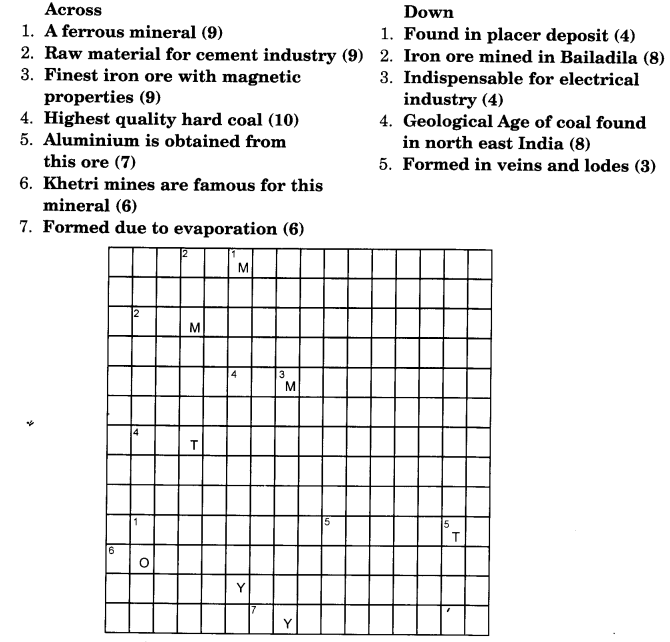
Answer:
Across
- Manganese
- Limestone
- Magnetite
- Anthracite
- Bauxite
- Copper
- Gypsum
Down
- Gold
- Hematite
- Mica
- Tertiary
- Tin
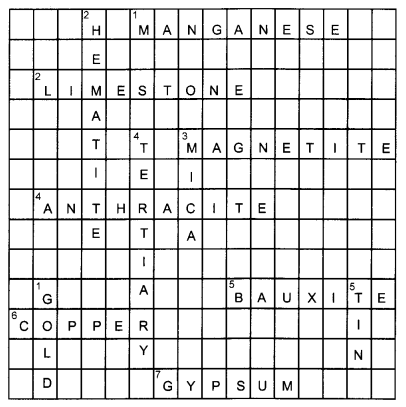
We hope the NCERT Solutions for Class 10 Social Science Geography Chapter 5 Minerals and Energy Resources help you. If you have any query regarding NCERT Solutions for Class 10 Social Science Geography Chapter 5 Minerals and Energy Resources, drop a comment below and we will get back to you at the earliest.
